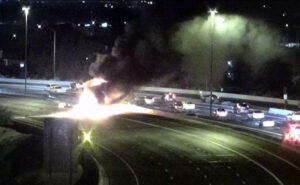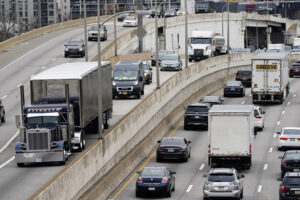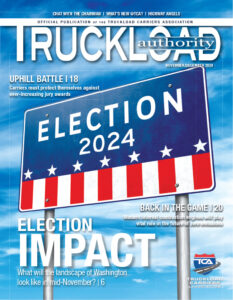CALIFORNIA TRUCKING ASSOCIATION APPEALS AB5 RULING TO U.S. SUPREME COURT
The U.S. Court of Appeals for the Ninth Circuit has granted the California Trucking Association’s (CTA) request for a stay of the AB5 mandate. This allows CTA to petition the U.S. Supreme Court to exclude owner-operators from the newly established restrictive three-prong requirements of independent contractors versus employees, according to a June 24 news alert issued by law firm Scopelitis, Garvin, Light, Hanson & Feary.
The Ninth Circuit Court previously denied CTA’s request for a review of the court’s April 28 decision that found CTA was unlikely to succeed on its claim that the Federal Aviation Administration Authorization Act of 1994 (F4A) preempts AB5.
The existing injunction against enforcement of AB5 for motor carriers will remain in place pending the Supreme Court’s ruling on CTA’s expected petition, according to Scopelitis attorneys.

If the Supreme Court declines to consider the case, “the mandate will issue immediately and the injunction will be dissolved by the district court,” stated the Scopelitis alert. “If the Supreme Court grants a writ to call up records of a lower court, the injunction will remain in place pending disposition on the merits.”
Truckload Carriers Association (TCA) Manager of Government Affairs Kathryn Pobre said the Supreme Court is the last hope that AB5 will be overturned.
“If the Supreme Court does not add AB5 to its calendar for 2022, the independent contractors will be viewed as employees of motor carriers, reversing a business model in California that has been in place for many, many years,” said Pobre.
The CTA’s Supreme Court review is due on or before November 18, 2021.
In its June 21 order, the Ninth Circuit said none of its judges requested a vote for reconsideration of the earlier denial.
“A stay of the mandate is plainly warranted under this court’s standards,” CTA said in a June 21 filing after the Ninth Circuit declined to rehear the issue.
CTA noted that the owner-operators who have offered their services as independent contractors will either have to close their small businesses and become employees or stop working in California.
“A stay of the mandate is needed to maintain the status quo while CTA contests the validity of California’s far-reaching worker-classification rule in the Supreme Court,” argued CTA.
AUDIT REVEALS ‘GAPS AND CHALLENGES’ IN FMCSA’S OVERSIGHT OF CDL DISQUALIFICATION REGS
An audit of the Federal Motor Carrier Safety Administration’s (FMCSA) oversight of commercial driver’s license (CDL) disqualification regulations revealed gaps and challenges in the process, which relies on state agencies to submit data related to commercial drivers’ traffic violations and convictions. The self-initiated audit, conducted by the U.S. Department of Transportation’s Office of Inspector General (OIG), was launched in fall of 2019 and completed this year.
According to the OIG’s report, states did not submit electronic conviction notices in a timely manner 17% of the time. Specifically, the OIG estimates that states did not transmit electronic data in a timely manner for 18% of 2,182 major offenses and 17% of 23,628 serious traffic violations.
In addition, the OIG estimates that 11% of the 2,182 major offenses noted above were not posted in a timely manner, and that 2% of the 23,628 serious traffic violations were never posted to driver records at all. The report shows states did take action to disqualify CDLs “when appropriate.” However, because electronic data was not always posted in a timely manner, FMCSA’s evaluation of conviction notices was sometimes hindered by states’ processes for sending the information by mail.
The report also notes that the FMCSA’s Annual Program Review process “lacks adequate quality control measures for verifying that state CDL programs meet federal requirements” and that state noncompliance with federal CDL disqualification requirements, along with other state actions, “pose challenges for FMCSA’s oversight.”
According to the OIG, some states offered administrative appeals to out-of-state drivers, overturned disqualifications and backdated CDL disqualification periods, which resulted in some drivers’ disqualification periods being shorter than required by federal law.
The OIG made seven recommendations to help FMCSA strengthen its oversight of states’ actions to comply with federal CDL disqualification requirements:
- Improve requirements for states to record, track, and maintain paper-based convictions sent and received via mail;
- Finalize and implement standardized operating procedures for conducting annual program reviews and for supervisory quality control reviews of completed annual program reviews;
- Modify the annual program review checklist to require reviewers to address key factors;
- Finalize and implement a standard operating procedure for determining when a state is not making a good-faith effort to mitigate compliance issues in a timely manner and when to impose sanctions on noncompliant states;
- Complete the agency’s review of the State Compliance Records Enterprise system and implement identified improvements for managing states’ compliance issues;
- Develop and implement a process to segregate non-CDL holder convictions from all CDL information system reports and workbooks utilized to evaluate state’s compliance with CDL regulations; and
- Develop and implement a plan for coordinating with the American Association of Motor Vehicle Administrators to mitigate risks when states transition to new software systems.
CONNECTICUT TO LEVY VMT TAX AGAINST LARGE TRUCKS

Beginning January 1, 2023, owner-operators and motor carriers transporting goods through Connecticut will be subject to a vehicle miles traveled (VMT) tax as high as 17.5 cents per mile, depending on the weight of the vehicle.
Connecticut House Bill (HB) 6688, which was passed by both houses of the state legislature in early June, was signed into law July 12 by the state’s Democratic Gov. Ned Lamont.
The tax, which Lamont refers to as a “highway user fee” for large commercial trucks, was originally part of the governor’s proposed state operating budget. The fees, applied to all roads within the state, will begin at 2.5 cents per mile for commercial trucks with a gross weight of 26,000 to 28,000 pounds and range up to 17.5 cents per mile for those weighing 80,000 pounds or more. Motor carriers will be required to calculate and file monthly returns for miles traveled on roads within Connecticut. The funds generated, expected to average $90 million annually, will be deposited into a special transportation fund.
Following outcry from members of the trucking industry against the state legislature’s passage of the bill, which many see as unfairly building the state’s tax base on commercial vehicles, Lamont took to social media to defend the fee.
“The trucking lobby is threatening to have drivers go around Connecticut because of the Highway User Fee. That’s fine. We’ll have less air pollution, safer, and better-quality roads, and less people with asthma. Looks like the Highway User Fee is already working,” Lamont said in a June 9 Twitter post.
Attached to the post was a video clip of Lamont making a statement to reporters, in which he noted that if trucking companies rerouted to avoid Connecticut, “We’ll still have the resources we need to make the investments we’ve got to.”
Following Lamont’s signing of HB 6688 into law July 12, Motor Transport Association of Connecticut (MTAC) President Joe Sculley noted that similar policies in other states have failed because they are difficult to enforce, according to CT News Junkie. MTAC has historically opposed truck-only user fees.
“You’re going to have out-of-state trucking companies either knowingly or unknowingly not pay it,” said Sculley. “That’s why it’s going to fail. We’re not going to get the money. The state is not going to get the tax revenue that they think they are and that’s going to cause a whole host of problems.”
BIPARTISAN BILL WOULD REPEAL FET ON HEAVY TRUCKS, TRAILERS

Efforts to repeal the federal excise tax (FET) on heavy trucks and trailers were renewed with the introduction of the Modern, Clean, and Safe Trucks Act of 2021 by Senators Ben Cardin (D-MD) and Todd Young (R-IN).
The FET was created more than a century ago to help pay for World War I. In 1917, the FET was established at 3%; today it stands at 12%.
According to a joint statement released by Cardin and Young, the 12% FET is the highest percentage excise tax levied on any product, effectively discouraging the investment in new, cleaner, and safer trucks and trailers. In addition, the statement noted that the FET “is an unpredictable and minimal source of revenue for the Highway Trust Fund.”
“Our tax policy is one of the most effective ways Congress can encourage cleaner and greener technology,” said Cardin. “The current federal excise tax has become a barrier to the progress.”
The legislation would repeal the FET on heavy-duty trucks, which currently adds approximately $22,000 to the cost of a new tractor trailer, according to the American Trucking Associations (ATA).
“It’s time to repeal this outdated and onerous tax on … truckers,” added Young. “Our bipartisan bill will open the floodgates to investment in safer and cleaner trucks and trailers that will benefit our economy and the environment.”
Even though technological advances have made the latest tractor-trailers cleaner and safer than ever before, the surcharges often discourage motor carriers from modernizing their fleets. As a result, the average tractor-trailer on the road today is nearly 10 years old. A 2020 survey conducted by ATA showed that 60% of fleets would be either “somewhat likely” or “very likely” to buy additional trucks and trailers beyond currently scheduled purchase if the FET were repealed.
Over the past two decades, cleaner fuel and engines used in new trucks have combined to reduce nitrogen oxide emissions by 97% and particulate matter emissions by 98%. Since 2010, more fuel-efficient diesel trucks have saved 101 million barrels of crude oil and reduced CO2 emissions by 43 million tons. Lifesaving driver-assist safety technologies that weren’t widely available or effective a decade ago, such as automatic emergency braking, forward collision mitigation and electronic stability technology, are now offered in new models.
American Truck Dealers Association’s Chairman Steve Bassett noted that the bill would “result in cleaner, safer trucks on the road,” adding that repealing the FET is “crucial to help America modernize its aging truck fleet.”
Cummins Inc., a manufacturer of engines for trucks and other equipment, also signaled support for the bill.
“Cummins supports Sens. Young and Cardin’s effort to repeal the outdated and burdensome federal excise tax on heavy duty trucks,” said Cummins President and Chief Operating Officer Jennifer Rumsey. “This tax penalizes those who want to adopt the cleanest, most advanced technologies to reduce emissions and improve safety, and repealing it will help ensure the most efficient technologies are being deployed.”
TRIP REPORT: 65-YEAR-OLD INTERSTATE HIGHWAY SYSTEM NEEDS OVERHAUL

The nation’s interstate highway system, originally funded in 1956, is now 65 years old — and there’s no question that it needs a lot of work.
According to a report released in June by TRIP, a private, nonprofit organization that researches, evaluates, and distributes economic and technical data on surface transportation issues, the interstate highway system is congested, carries significant levels of travel — particularly by large trucks — and lacks adequate funding to make needed repairs and improvements.
The findings of the report, “America’s Interstate Highway System at 65: Meeting America’s Transportation Needs with a Reliable, Safe & Well-Maintained National Highway Network,” show that this critical transportation link will need to be rebuilt and expanded to meet the nation’s growing transportation needs, TRIP said in a news release.
The report looks at the interstate system’s use, condition, and benefits, along with the findings of a 2019 report by the Transportation Research Board (TRB), prepared at the request of Congress as part of the Fixing America’s Surface Transportation (FAST) Act, on the condition and use of the interstate system and actions required to restore and upgrade the interstate system.
According to the 2019 TRB report, the interstate system has a persistent and growing backlog of physical and operational deficiencies as a result of age, heavy use, and deferred reinvestment, and needs major reconstruction and modernization. The TRB report concludes that annual investment in the interstate highway system should be increased approximately two-and-a-half times, from $23 billion in 2018 to $57 billion annually over the next 20 years.
“The report released by TRIP confirms what American businesses experience every day — our interstate highway system, which was once the envy of the world, is in serious need of modernization,” said U.S. Chamber of Commerce Vice President of Transportation Infrastructure Ed Mortimer. “Commitment to modernization must be shared by federal, state, and local leaders as well as the private sector. The interstate system plays a key national role in economic success and quality of life for every American, and we urge bipartisan solutions this year to address this critical issue.”
The TRIP report found that travel on the interstate system from 2000 to 2019 increased by 26%, a rate nearly triple that at which new lane capacity was added. As a result, 47% of urban interstate highways are considered to be congested during peak hours. Due to the COVID-19 pandemic, vehicle travel on U.S. highways dropped by as much as 45% in April 2020 but rebounded to only 6% below April 2019 levels by April 2021.
The report also found that travel by combination trucks on the interstate increased at a rate more than double that of overall vehicle travel between 2000 and 2019. Combination truck travel on the interstate system increased 43% from 2000 to 2019, while overall vehicle travel increased 19%.
The design of the interstate system — which includes a separation from other roads and rail lines, a minimum of four lanes, paved shoulders, and median barriers — makes it more than twice as safe to travel on as all other roadways. The fatality rate per 100 million vehicle miles of travel on the interstate in 2019 was 0.55, compared to 1.3 on non-interstate routes. TRIP estimates that additional safety features on the interstate highway system saved 6,555 lives in 2019.
SURPRISE BRAKE CHECK

During an unannounced Brake Safety Day held May 26, commercial motor vehicle inspectors in Canada, Mexico, and the U.S. conducted 10,091 inspections and placed 1,273 vehicles out of service for brake-related critical vehicle inspection items. Inspectors tracked and reported data collected during the one-day inspection and enforcement initiative to the Commercial Vehicle Safety Alliance (CVSA).
“Inspectors conducted their usual inspections and reported brake-related data to CVSA for Brake Safety Day,” said CVSA President Sgt. John Samis with the Delaware State Police. “We are sharing the results to call attention to the importance of CMV brake safety.”
According to CVSA, brakes are one of a commercial vehicle’s most important systems, but brake-related violations are one of the top culprits when vehicles are placed out of service. Brake system violations was the top vehicle out-of-service category during the 2020 International Roadcheck.
On Brake Safety Day each year, CVSA-certified inspectors conduct inspections, focusing on the vehicle’s brake systems and components, and remove commercial vehicles that have brake-related out-of-service violations from roadways.
Here are the details from the May surprise check:
- Six jurisdictions from Canada, 42 U.S. jurisdictions, and Mexico’s Ministry of Communications and National Guard participated in the initiative.
- Inspectors conducted a total of 10,091 inspections and placed 1,273 vehicles out of service for brake violations.
- The brake-related out-of-service rate in North America was 12.6%.
- The U.S. brake-violation out-of-service rate was 13.3%. In Canada, the rate was 11.4%, and in Mexico, the rate was 2.9%.
- In Canada, 946 inspections were conducted. In Mexico, inspectors conducted 487 inspections, and in the U.S., 8,658 inspections were conducted.
- Fourteen vehicles were removed from roadways in Mexico for brake violations. In Canada, 108 vehicles were placed out of service for brake violations, and in the U.S., 1,151 vehicles were removed from roadways because of brake violations.
Brake hoses/tubing were the focus area for this year’s Brake Safety Day. Canada, Mexico, and the U.S. reported a total of 1,725 brake hoses and tubing violations from the initiative. Canada reported 251 chafing violations, Mexico reported 186, and the U.S. reported 1,288.
Brake hose/tubing chafing violations are divided into five categories according to the severity of the damage or wear and tear.
“Brake hoses and tubing are essential brake system components and must be properly attached, undamaged, without leaks and flexible,” said Samis. “We chose to focus on brake hoses/tubing this year in an effort to reduce deaths and injuries as a result of CMV brake-system failures from pressure or vacuum loss due to brake hose/tubing deficiencies.”
As part of the vehicle inspection process, some jurisdictions in the U.S. use performance-based brake testers that assess a vehicle’s braking performance. On Brake Safety Day, 68 of these tests were conducted and 4% of tested vehicles were placed out of service for insufficient brake performance.
US REGULATORS SEEK AUTOMATED BRAKING REQUIREMENT

In a reversal from former President Donald Trump’s administration policies, U.S. auto safety regulators say they will move to require or set standards for automatic emergency braking systems on new heavy trucks.
The Department of Transportation, which includes the National Highway Traffic Safety Administration (NHTSA), announced the change when it released its spring regulatory agenda.
It will also require what it said are rigorous testing standards for autonomous vehicles, and set up a national database to document automated-vehicle crashes.
The moves by the administration of President Joe Biden run counter to the agency’s stance under the Trump administration. NHTSA had resisted regulation of automated-vehicle systems, saying it didn’t want to stand in the way of potential life-saving developments. Instead, it relied on voluntary safety plans from manufacturers.
NHTSA had proposed a regulation on automatic emergency braking in 2015 before Trump took office, but it languished in the regulatory process. The agency says it has been studying the use of the electronic systems and that it plans to publish a proposed rule in the Federal Register in April 2022. When a regulation is published, it opens the door to public comment.
“We are glad to see NHTSA finally take the next step in making large trucks safer by mandating AEB,” said Center for Auto Safety Executive Director Jason Levine. The center was among the groups that petitioned for the requirement in 2015.
“Unfortunately, at this rate, it will still be years until the technology that could help stop the 5,000 truck crash deaths on our roads is required,” he said in an email.
A trade group representing independent professional truck drivers said the technology isn’t ready for heavy vehicles and can unexpectedly activate without reason.
“Our members have also reported difficulties operating vehicles in inclement weather when the system is engaged, which has created safety concerns,” added the Owner-Operator Independent Drivers Association in a statement.
The association said that because the technology is still being perfected, legislators and regulators shouldn’t set time frames for requiring it on all trucks.
However, the Insurance Institute for Highway Safety, a research group supported by auto insurers, reported in a study last year that automatic emergency braking and forward-collision warnings could prevent more than 40% of crashes in which semis rear-end other vehicles. A study by the group found that when rear crashes happened, the systems cut speeds by more than half, reducing damage and injuries.
Advocates for Highway and Auto Safety (AHAS), another group that sought the regulation from NHTSA in 2015, said the agency is moving too slowly by not publishing the regulation until next year.
“I don’t understand the delay,” said AHAS President Cathy Chase. “I know that might sound impatient, but when people are dying on the roads — 5,000 people are dying on the roads each year, and we have proven solutions — we would like to see more immediate action.”
In 2016, NHTSA brokered a deal with 20 automakers representing 99% of U.S. new passenger vehicle sales to voluntarily make automatic emergency braking standard on all models by September 1, 2022. However, that deal did not apply to large trucks.
NHTSA PROBES OVERHEATING BRAKES

U.S. highway safety regulators have opened an investigation into about a half-million semis with brakes that can catch fire.
The National Highway Traffic Safety Administration (NHTSA) said in documents posted on its website July 20 that it has received 11 complaints about brakes made by Haldex Commercial Vehicle Systems, including seven fires. No injuries have been reported.
The complaints say problems occurred mostly on Kenworth and Peterbilt tractors. The agency is investigating brakes on model year 2015-2020 semis.
NHTSA said the investigation covers certain Haldex Gold Seal brake chambers, which convert compressed air into a mechanical force that stops the trucks. It says a spring can fracture, puncturing a diaphragm, and causing air loss. That can make the brakes drag without warning to the driver and eventually cause fires.
The fires caused extensive damage to the trucks, and in some cases the cargo, the agency reported. NHTSA says it has learned multiple truck fleets were having issues with the brake chambers. It states Haldex has replaced brake chambers on some vehicles in the fleets.
NHTSA said it will determine how often the problem happens and what models it affects. An investigation can lead to a recall.
NHTSA ORDERS REPORTING OF AUTOMATED VEHICLE CRASHES
The National Highway Traffic Safety Administration (NHTSA) has ordered automakers to report any crashes involving fully autonomous vehicles or partially automated driver-assist systems.
The move by the U.S. government’s highway safety agency indicates it is taking a tougher stance on automated vehicle safety than in the past. It’s been reluctant to issue any regulations of the new technology for fear of hampering adoption of the potentially life-saving technology.
The order requires vehicle and equipment manufacturers and operators to report crashes on public roads involving fully autonomous vehicles, or those in which driver-assist systems were operating immediately before or during a crash.
“By mandating crash reporting, the agency will have access to critical data that will help quickly identify safety issues that could emerge in these automated systems,” said NHTSA Acting Administrator Steven Cliff in a statement.
The agency shared that it will look for potential safety defects, and the information could trigger an inspection by a crash investigation team or a defect investigation.
The order comes after NHTSA dispatched crash investigation teams to 31 crashes involving partially automated driver-assist systems since June of 2016. Such systems can keep a vehicle centered in its lane and a safe distance from vehicles in front of it. Of those crashes, 25 involved Tesla’s Autopilot system in which 10 deaths were reported, according to data released by the agency.
The National Transportation Safety Board (NTSB), which has also investigated some of the Tesla crashes, has recommended that NHTSA and Tesla limit Autopilot’s use to areas where it can safely operate. The NTSB also recommended that NHTSA require Tesla to have a better system to make sure drivers are paying attention.
The Center for Auto Safety, a nonprofit advocacy group, said the crash reporting is a welcome first step by NHTSA. The center has been asking the agency to oversee automated vehicles for several years.
The Truckload Authority News Staff, comprised of award winning journalists and graphic artists, produces content for Truckload Authority, working in cooperation with the Truckload Carriers Association staff. Truckload Authority aims to keep TCA members abreast on the latest trends in the trucking industry as well as articles that feature TCA member executives and drivers. The Truckload Authority staff is based in Little Rock, Arkansas.







